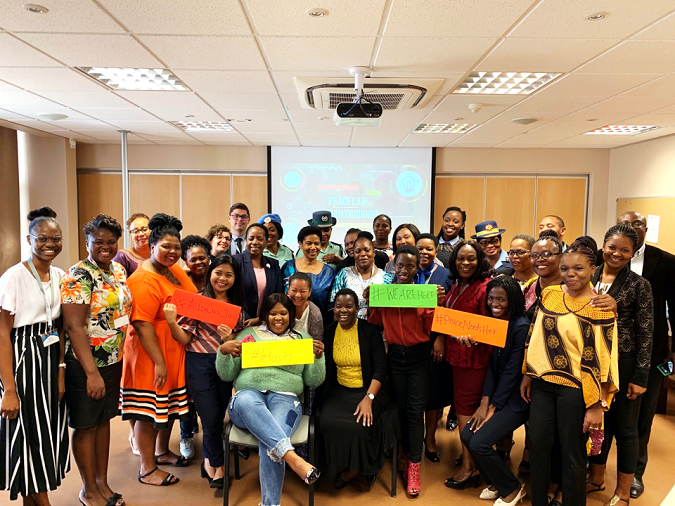Peace Lab at the 3rd Capital Meeting of Women, Peace and Security Focal Points, tackles the challenges of youth participation in peace and security
Date:

Multi-coloured pieces of paper are strewn across tables along with bright markers, glue and note paper as youth activists from across the world, intensely discuss challenges and solutions to ensuring that young people and young women, are included in peace making and peace building processes at local, national and regional levels.
The youth leaders were taking part in a design thinking exercise, facilitated by South African based innovation social enterprise, R Labs, where they were tasked with deriving solutions to increase the participation and effectiveness of youth in peace and security.
Design thinking is based on the understanding that sustainable solutions to any social challenges must take the circumstances, needs, limitations, strengths and preferences of people into consideration. UN Women is therefore looking to tap into this innovative and contextual way of deriving solutions to address some of the most pressing issues affecting women and girls. For the Peace Lab, the key objective was to create a space where women and youth leaders could bring their knowledge, experience and creativity to come up with innovative solutions.
In four groups, a mix of youth leaders, youth activists, young parliamentarians, members of defence and security forces, and representatives from civil society organisations began the process by identifying and understanding barriers to youth and particularly young women’s participation. Top barriers identified included a lack of inclusion and gender equality, negative gender and social/cultural norms and negative stereotypes, and a lack of recognition of the ability of young people and young women to add value.
After identifying barriers to youth and women’s participation, each group then came up with hashtags that would both resonated with and responded to the barriers. These were #wearehere, #letusin, #allowusin, #allowusto, #ownyourvoice, and #peaceneedsher.
In group feedback presentations on chosen hashtags, Nompendulo Mkatshwa, a youth activist from South Africa (whose team came up with #peaceneedsher) explained that young women were often consulted as stakeholders even when they had received training on peace processes. “We need to train with the intent of having young women at the table, not consulted with as a stakeholder but actually part of those leading the peace processes.”
The groups were then asked tasked to develop innovative ideas that will address the barriers using various brainstorming and ideation techniques. They also had to identify the specific characteristics of the young woman facing the barriers and mapped out stakeholders who could help her overcome those barriers.
On the second day of the lab, UN Women Executive Director Phumzile Mlambo-Ngcuka joined the session and encouraged the youth leaders in the room to drive inclusion and space for youth and to continue leading the way in solving pressing challenges.
“I actually like the fact that you are owning the solutions, you are not talking about how you need to go to someone that must rescue you out of the situation; you actually want to be part of the process to make the solutions happen and to create them; and you are not throwing stones and blaming people. That is also very refreshing. You are just saying, ‘open the door; we want to be in, and we have a job to do.’”
She also acknowledged that the realisation of the women, peace and security agenda was impossible without the involvement of youth, especially young women, and emphasised the intersection of the youth and women agendas on peace and security. “As we move towards 20 years of implementing UNSCR Resolution 1325, one thing that we are taking with us is the fact that the exclusion of women in general in the peace processes has compromised the quality of the peace that we have. And who are we to exclude young people, young women in particular when we know what it has meant to exclude women in general?”
At the end of the PeaceLab, four solutions were prototyped:
- Women and Youth Centres which bring together all relevant stakeholders to formulate policy on women’s participation. The draft policies are then presented to national government for adoption and implementation.
- Online communities where young women share their stories and strategise on how they can contribute to peace and security in the region.
- Bills on the inclusion of women and youth in decision making (following local and national level consultations) which would lead to an action plan where councils made up of government and civil society are elected to oversee implementation of the Bill.
- Affirmative action for young women’s participation in peace processes (or a quota system) to ensure representation in negotiation, mediation and as signatories.
The prototypes will now be analysed by UN Women and RLabs, and one viable option will be fully developed.
Reporting to the plenary, Rita Moyo a social worker based at the International Women Peace group said it was time that youth became more than a stakeholder that could be consulted. “You used to call us and say we are having consultations with youth, we want them to bring their ideas. The tables have turned – we want to come consult you when we need ideas or when we need to be guided.”